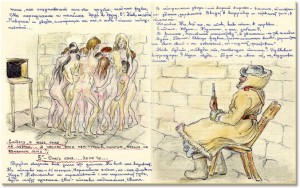While I am usually pleased by events which raise the public profile of the Gulag, I am distinctly less comfortable with its use for anti-Russian/anti-Soviet propaganda by neoconservative American think-tanks who have failed to notice that the Cold War ended twenty years ago, as in the case of the Heritage Foundation’s current exhibition of Nikolai Getman’s Gulag art.
The whole of Getman’s Gulag Collection can be found on the website of the Jamestown Foundation, which was founded in 1984 to support the activities of Soviet dissidents and has been accused of being anti-Russian. This may have been Getman’s choice, but for me this sort of presentation, which places the art in the service of a dubious and outdated policy agenda, undermines its relevance and diminishes its impact. Unfortunately, the same sort of approach has hindered the development of a sensible critical discourse on the literature of the Gulag, much of which appeared in translation in the sixties and seventies and was subject to vague, journalistic reporting that focused on fulminating against the evils of the Soviet empire and celebrating the triumph of the human spirit represented by the survivors’ writings, rather than actually interrogating the texts in an intelligent way. Solzhenitsyn’s Gulag works suffered particularly from this tendency, and their reputation, sadly, has never really recovered, while Shalamov, who didn’t fit into the dissident mould, was largely ignored as a result, and again, this had a long standing impact on his reception.
Refuting the Jamestown Foundation’s claim that Getman’s art is the only visual record of the Gulag, the website of Eufrosinia Kersnovskaya’s extraordinary and evocative illustrations of her twelve years in the Gulag allows the pictures to speak for themselves. Only the introductory section of the website so far been translated into English (one hopes that ultimately the whole site will be translated), but the Kersnovskaya Foundation has made a number of images available under a Creative Commons License via Wikipedia, including this one of women huddled together in a bathhouse, ‘Banya on cold stone floor: even the guard in the fur coat didn’t look too warm’:


edwin
/ November 7, 2009Sarah,
Thank you for this as I had not been familiar with Kersnovskaya before.
I have updated my own posting on the “collection” of art from the Gulag, not actually noticing the claim before by the Jamestown Foundation. I hope they have corrected that.
As for your comments regarding the Heritage Foundation as well the Jamestown Foundation from a political and end of The Cold War perspective, I find that interesting.
What does it mean to you and perhaps also, generally, today to be “anti-Russian”?
edwin
/ November 7, 2009In re: “only visual record” I found it and shall also add my voice to correcting that.
Quote from Jamestown Foundation site:
“Getman’s collection is unique because it is the only visual record known to exist of this tragic phenomenon. Unlike Nazi Germany, which recorded and preserved in detail a visual history of the Holocaust, the Russians prefer not to remember what happened in the GULAG. Not a single person has been punished for the deaths of the millions who perished there. If film or other visual representations of the Soviet GULAG existed, they have been largely destroyed or suppressed. The Getman collection stands alone as a most important historical document.”
Yes, that is NOT true.
Sarah Young
/ November 13, 2009When you start to think about it, even if many were destroyed, there are still plenty of visual records of the Gulag. The early days, at least, were well documented. Rodchenko’s photographs of convicts working on the White Sea Canal are a good example.